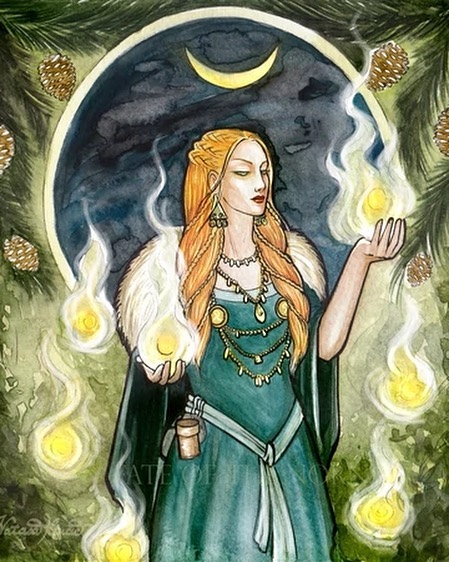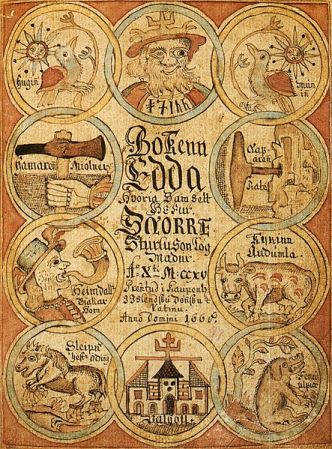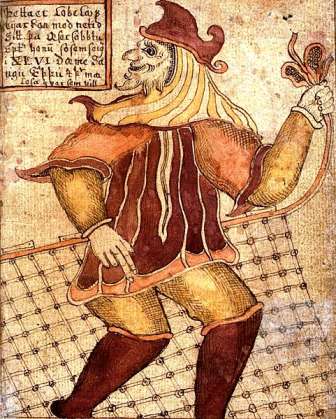In the stories of Norse mythology, Laufey stands out as a woman of intrigue and mystery. Only really known as the mother of the infamous Loki, Laufey’s story is not well known. This is interesting in itself as her son and his descendants basically bring about the end of the world.
Laufey Key Facts
| Parents | Unknown |
| Partners | Fárbauti |
| Siblings | Not specified |
| Offspring | Loki, Helblindi, and Býleistr |
| Tribe | Jötun |
| Old Norse name | Laufey |
| Other names | Nál |
Name and Etymology
Laufey’s name in Old Norse is based on the word “lauf,” possibly meaning ‘leaves’ or ‘foliage.’ This connection suggests a deep bond with nature, perhaps hinting at her dwelling or her intrinsic nature. The suffix “-ey” is often found in female personal names like Bjargey and Þórey. In this context, “-ey” is a singular version of the plural “-eyjar,” which translates to “island” or “islands.” Drawing from this, Laufey’s name can be interpreted as “the leafy island” or “the island of foliage.” This interpretation paints a vivid picture of a goddess deeply connected to nature, perhaps overseeing a realm of lush greenery and natural beauty.
Interestingly, in one instance, Loki is mentioned as Loki Laufeyjarson, not just Laufeyson. This addition of -jar, make me believe interpreting her name as meaning leaf/foliage-island/s, seem even more plausible.
Furthermore, Laufey is also known by another name: Nál. In Old Norse, “Nál” translates to “needle.” Given this meaning, it’s plausible to draw a connection between Nál and the slender, pointed leaves of pine trees, akin to pine needles. This interpretation not only reinforces Laufey’s association with nature but also paints a picture of a figure that embodies the delicate yet enduring qualities of pine trees, standing tall and unyielding amidst the harshest of conditions.
To illustrate the significance of the “-ey” suffix, consider the name of the Orkney islands. “Orkn-” stands for seals, and when combined with “-ey,” the name translates to “Seal Island.” This method of naming showcases the Norse tradition of combining nature’s elements with geographical markers, creating names rich in imagery and meaning.
Ancient roots
While Laufey’s name is deeply rooted in Norse mythology, there isn’t substantial evidence to suggest that it predates Norse myths or stretches back into older mythologies like Germanic or Gothic. However, the concept of giantesses and their roles in various mythologies is a recurring theme, suggesting a shared cultural understanding or appreciation for these powerful female figures.
Laufey Origins
Laufey’s role in Norse mythology is both captivating and somewhat elusive. Contrary to various modern websites and interpretations, the primary ancient texts do not explicitly label her as a jötun.

Furthermore, she isn’t listed as one of the Asynjur (Aesir goddesses) in the Nafnathulur (Names of things and people/gods) as the end of the Skáldskaparmál either. Thi sis also contrary to this being tossed around on many websites as a “fact”. There are no less than thirty Asynjur listed there, none of them are Laufey, or Nál
The only thing I personally find as a convincing argument for her being an Aesir is the naming convention used for her son, Loki. He is often referred to as Loki Laufeyjarson, named after Laufey rather than his father, Fárbauti. This maternal naming is unusual in Norse tradition and might hint at Laufey’s unique status or importance. However, it’s essential to note that despite these connections, Laufey has always been portrayed as a figure with a minor role in the vast tapestry of Norse myths.
Laufey Family and Relationships
Laufey’s relationships, particularly with her partner the jötun Fárbauti, are central to her narrative. Their union produced three offspring: Loki, the trickster god; Helblindi; and Býleistr. While Loki is well known, both Helblindi and Býleistr are largely unknown.
Loki
Laufey’s most renowned offspring is Loki, the trickster god. His adventures and misadventures are legendary within the Norse pantheon. While his lineage from Laufey is clear, the relationships and connections he shares with other figures in the myths are often intricate and not always explicitly defined in the ancient texts.
Helblindi and Býleistr
Loki is often associated with two brothers, Helblindi and Býleistr. The common assumption is that they share the same parents as Loki, but there’s no direct textual evidence to confirm this. They are mentioned as Loki’s brothers, but their exact parentage remains a mystery. This ambiguity leaves room for various interpretations and speculations.
It’s possible that one or both of them have different parents, a scenario not uncommon in the Norse pantheon. Indeed, many deities often have half-siblings from various unions. Another possibility is that they are step-brothers to Loki or even blood-brothers without sharing the same paternal lineage.
An intriguing point to consider is the mention of “Helblindi” as one of Odin’s names in the Grimnismál. Given the undeniable bond between Loki and Odin, a bond whose origins are somewhat mysterious, this shared name could offer a clue. Could it be that Helblindi is a link between the two, hinting at a deeper connection or shared history? While this is purely speculative, it’s a fascinating possibility that adds another layer of depth to the intricate relationships within the Norse gods’ realm.
Laufey Role And Depiction
Laufey’s primary role in Norse mythology is as the mother of Loki. For humans, Laufey’s presence is more ambiguous. While she isn’t directly involved in many myths, her indirect influence, particularly through Loki, is undeniable. Her personality, based on limited references, seems to be one of strength, resilience, and perhaps a touch of mystery.
Laufey Symbols, Artifacts, or Animals
There aren’t specific artifacts or symbols directly associated with Laufey in the ancient texts. However, given her name’s connection to nature (“Leafy Isle”), it’s plausible to associate her with forests, trees, or greenery. This association paints a picture of Laufey as a guardian or spirit of nature, overseeing the wild landscapes of the Norse world.
Mentions in Ancient Texts
Prose Edda

Gylfaginning (‘The Beguiling of Gylfi’)
In this section of the Prose Edda, High introduces Loki as the son of Fárbauti, mentioning that “Laufey or Nál” is his mother. Furthermore, it’s here that Loki’s brothers, Býleistr and Helblindi, are first named. The matronymic Laufeyjarson (‘Laufey’s son’) is used to refer to Loki, emphasizing his maternal lineage. This matronymic reference occurs twice more in Gylfaginning and once in Skáldskaparmál.
Skáldskaparmál (‘The Language of Poetry’)
In Skáldskaparmál, Loki’s lineage is again touched upon. There he is mentioned as the ‘son of Fárbauti’ or ‘son of Laufey’. Additionally, Nál is referenced in the context of “Laufey or Nál”, further solidifying her identity and connection to Loki.
The mentions of Laufey and Nál provide valuable insights into the relationships and lineages within the Norse pantheon. The emphasis on matronymics, Loki’s surname being ‘Laufeyjarson (son of Laufey), from his mother is an interesting point.
Laufey is not mentioned as an Asynjur in the Nafnathulur
I’ve come across an often-repeated “fact” online that claims Laufey is listed among the Asynjur (Aesir goddesses) in the Nafnathulur. They are found at the end of the Skáldskaparmál. I felt compelled to address this misconception. Having read through several English translations, as well as an Old Norse version, I find this claim is inaccurate. Laufey is not one of the thirty goddesses listed there. We don’t known anything directly about her origins, and she could be an Aesir, or a jötun. As is often the case with Norse mythology, some of this knowledge has sadly been lost through the centuries.
Frequently Asked Questions
Laufey is the mother of Loki, Helblindi, and Býleistr.
Laufey is a jötun giantess in Norse mythology.
Laufey’s name translates to “Leafy Isle” in Old Norse.
We do not have any reliable information about her parents. She is liated among the asynjur though, so probably some early Aesir.
Yes, Laufey is mentioned in both the “Prose Edda” and “Poetic Edda.”
Laufey is Loki’s mother, and he often carries her name in various kennings.
Featured Image Credit: ancientreasuresbrand via Instagram


Hi there! Great article. I always found Loki and his parentage to be an extremely interesting subject. I always compared the shapeshift gender of Loki to his parentage. Laufey being a somewhat neutral or good (potentially aesir) person and Fárbauti being either evil or chaotic as a jötun. When Loki is in the shape of a female (like the horse who helped distract the builder’s animal) he is helpful, but as a male he seems to be more chaotic and disruptive.
Regardless, I have been trying to find Norse runic script (Old Norse) for Laufey. If you’d be able to help me that would be splendid. Thanks for a great read!
Hi Jack, thanks for your great insight! There is often deeper symbolism (often lost through time) in many of the sagas and myths, Loki representing both good and evil (or chaos) is likely an area where much is lost. There is an excellent online source where you should be able to track down Laufey in Old Norse, not in runes thouhg. You can find it here: https://heimskringla.no/wiki/Forside They have it in English as well!
Marius
Just mentioning a minor mistake: You have “Who are “HER” parents (Laufey)?”, and answer “Laufey’s parents are Nál and Fárbauti.”
I know you probably meant, “Who are Loki’s parents?” and then answered, “Loki’s parents are Nál and Fárbauti.” But that’s just my assumption.
And TJ forgets Loki giving birth to Hel, Fenrir, and Jörmungandr…he kindly lets Sigyn have Narfi and Vali, though…I think he liked the experience of giving birth to the destructive ones!
Skál!
Hi Kristi, really appreciate you noticing this. As the post is about Laufey, the information would be all wrong either way as we don’t really have any information about her background. She is listed as an asynjur thoiugh, which opens up a few interesting possibilities. That would likely mean she was a sister or cousin of Odin, coming from the same generation of the Aesir.
Then, while Loki intetrestingly did in fact give birth to Sleipnir, his jötun concubine Angrboda is the mother of the three siblings of the Apocalypse/Ragnarök. Finally, I do not believe that Vali is somehow a myterious, never mentioned, son of Loki, rather he is Odin’s son Vali, the god of retribution, changing into the shape of a wolf in order to rip poor Narfi apart.
Loki seems cast as both male and female, given the horse birth. Could Loki be plural as in twins? One Loki Laufeyson and another the Loki Laufeyjarson? Perhaps it was Sigyn who sooths Loki Laufeyson? Sleipnir would have come from Laufeyjarson then.
Hey TJ, thanks for your interesting insight and question. I believe the answer is that Loki was a shapeshifter able to change into any form.. like he transforms into a pike (or salmon) to evade capture at the end of Lokasenna. In that poem Odin also alludes to some lost story about how Loki lived as a woman for years…. I understand that as he “was” a woman. Either way, shifty guy for sure 😉